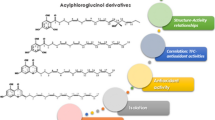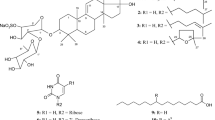Abstract
The aim of this paper is to report the results of investigations into the antioxidant effect of dihydrofurocoumarins (1–6), isolated from the salt marsh plant Corydalis heterocarpa. The scavenging activities of the isolated compounds against DPPH radicals, hydroxyl radicals, and superoxide radicals were evaluated by electron spin resonance. The protective activities of these compounds against hydroxyl radical-mediated genomic DNA damage and peroxynitrite-mediated dihydrorhodamine oxidation were also investigated. The experimental results show that most compounds had antioxidant activity but their capabilities differed a little for the different indicators. Among them, compound 6 exerted the strongest antioxidant activity at a concentration of 100 μM/mL for all tested bioassay systems, compared with other compounds.
Similar content being viewed by others
References
Lee, Y. N. (2002) Flora of Korea. p. 271. Kyo-Hak Publishing Co. Ltd., Seoul, Korea
Ma, W. G., Y. Fukushi, and S. Tahara (1999) Fungitoxic alkaloids from Hokkaido Corydalis species. Fitoterapia 70: 258–265.
Tatsuzawa, F., Y. Mikanagi, N. Saito, K. Shinoda, A. Shigihara, and T. Honda (2005) Cyanidin glycosides in flowers of genus Corydalis (Fumariaceae). Biochem. Syst. Ecol. 33: 789–798.
Choi, S. U., N. I. Baek, S. H. Kim, J. H. Yang, J. S. Eun, T. Y. Shin, J. P. Lim, J. H. Lee, H. Jeon, M. Y. Yun, K. H. Leem, H. W. Park, and D. K. Kim (2007) Cytotoxic isoquinoline alkaloids from the aerial parts of Corydalis incise. Arch. Pharm. Res. 30: 151–154.
Kim, Y. A., C.-S. Kong, S. S. Yea, and Y. Seo (2010) Constituents of Corydalisheterocarpa and their anti-proliferative effects on human cancer cells. Food Chem. Toxicol. 48: 722–728.
Martin-Aragon, S., J. Benedi, and A. Villar (1996) Oxygen active species-scavenger properties of coumarins. Phytother. Res. 10: S75–S78.
Ngi, T. B., F. Liu, and Z. T. Wang (2000) Antioxidative activity of natural products from plant. Life Sci. 66: 709–723.
Fylaktakidou, K. C., D. J. Hadjipavlou-Litina, K. E. Litinas, and D. N. Nicolaides (2004) Natural and synthetic coumarin derivatives with anti-inflammatory/antioxidant activities. Curr. Pharm. Design10: 3813–3833.
Gacche, R. N. and S. G. Jadhav (2012) Antioxidant activities and cytotoxicity of selected coumarin derivatives: Preliminary results of a structure-activity relationship study using computational tools. J. Exp. Clin. Med. 4: 165–169.
Sandhu, S., Y. Bansal, O. Silakari, and G. Bansal (2014) Coumarin hybrids as novel therapeutic agents. Bioorg. Med. Chem. 22: 3806–3814.
Paya, M., B. Halliwell, and J. R. S. Hoult (1992) Interactions of a series of coumarins with reactive oxygen species. Biochem. Pharmcol. 44: 205–214.
Tyagi, Y. K., S. Tyagi, H. J. Raj, and R. K. Gupta (2010) In vitro antioxidant activity evaluation of 4-methyl coumarin derivatives. Asian J. Chem.22: 3622–3628.
Thong, P. T., T. M. Hung, T. M. Ngoc, D. T. Ha, B. S. Min, S. J. Kwack, T. S. Kang, J. S. Choi, and K. H. Bae (2010) Antioxidant activities of coumarins from Korean medicinal plants and their structure — activity relationships. Phytother. Res. 24: 101–106.
Paya, M., P. A. Goodwin, B. De Las Heras, and R. S. Hoult (1994) Superoxide scavenging activity in leukocytes and absence of cellular toxicity of a series of coumarins. Biochem. Pharmacol. 48: 445–451.
Nanjo, F., K. Goto, R. Seto, M. Suzuki, M. Sakai, and Y. Hara (1996) Scavenging effects of tea catechins and their derivatives on 1,1-diphenyl-2-picrylhydrazyl radical. Free Radical Bio. Med. 21: 895–902.
Rosen, G. M. and E. J. Rauckman (1984) Spin trapping of superoxide and hydroxyl radicals. pp. 198-209. In: L. Packer (ed.), Methods in Enzymology. Academic Press, Orland, USA.
Guo, Q., B. Zhao, S. Shen, J. Hou, J. Hu, and W. Xin (1999) ESR study on the structure-antioxidant activity relationship of tea catechins and their epimers. Biochim. Biophys. Acta 1427: 13–23.
Kooy, N. W., J. A. Royall, H. Ischiropoulos, and J. S. Beckman (1994) Peroxynitrite-mediated oxidation of dihydrorhodamine 123. Free Radical Bio. Med. 16: 149–156.
Sambrook, J. and D. W. Russell (2001) Molecular Cloning: A Laboratory Manual. 3rd ed., Cold Spring Harbor Laboratory Press, NY, USA.
Milne, L., P. Nicotera, S. Orrenius, and M. Burkitt (1993) Effects of glutathione and chelating agents on copper-mediated DNA oxidation: Pro-oxidant and antioxidant properties of glutathione. Arch. Biochem. Biophys. 304: 102–109.
Cacciuttolo, M. A., L. Trinh, J.A. Lumpkin, and G. Rao (1993) Hyperoxia induces DNA damage inmammalian cells. Free Radical Bio. Med. 14: 267–276.
Jiang, L. Y., S. Heb, Y. J. Pan, and C. R. Sun (2010) Bioassayguided isolation and EPR-assisted antioxidant evaluation of two valuable compounds from mango peels. Food Chem. 119: 1285–1292.
Ippoushi, K., A. Takeuchi, and K. Azuma (2009) Prevention of peroxynitrite-induced oxidation and nitration reactions by ellagic acid. Food Chem. 112: 185–188.
Ho, S.-C., Y.-L. Tang, S. M. Lin, and Y.-F. Liew (2010) Evaluation of peroxynitrite-scavenging capacities of several commonly used fresh spices. Food Chem. 119: 1102–1107.
Mello, L. D., S. Hernandez, S. Marrazza, M. Mascini, and L. T. Kubota (2006) Investigations of the antioxidant properties of plant extracts using a DNA-electrochemical biosensor. Biosens. Bioelectro. 21: 1374–1382.
Zhang, R., K. A. Kang, M. J. Piao, D. O. Ko, Z. H. Wang, W. Y. Chang, H. J. You, I. K. Lee, B. J. Kim, S. S. Kang, and J. W. Hyun (2009) Preventive effect of 7,8-dihydroxyflavone against oxidative stress induced genotoxicity. Biol. Pharm. Bull. 32: 166–171.
Wang, H., X. D. Gao, G. C. Zhou, L. Cai, and W. B. Yao (2008) In vitro and in vivo antioxidant activity of aqueous extract from Choerospondia saxillaris fruit. Food Chem. 106: 888–895.
Spencer, W. A., J. Jeyabalan, S. Kichambre, and R. C. Gupta (2011) Oxidatively generated DNA damage after Cu (II) catalysis of dopamine and related catecholamine neurotransmitters and neurotoxins: Role of reactive oxygen species. Free Radical Bio. Med. 50: 139–147.
Jeong, J. B., E. W. Seo, and H. J. Jeong (2009) Effect of extracts from pine needle against oxidative DNA damage and apoptosis induced by hydroxyl radical via antioxidant activity. Food Chem. Toxicol. 47: 2135–2141.
Wang, L., Y. Song, X. Zhang, and Y. Liu (2006) An exploratory theoretical elucidation on the peroxyl-radical scavenging mechanism and structure-activity relationship of nonsteroidal antiinflammatory drugs. Bioorg. Med. Chem. Lett. 16: 3241–3244.
Najafi, M., M. Najafi, and H. Najafi (2012) DFT/B3LYP study of the substituent effects on the reaction enthalpies of the antioxidant mechanisms of indole-3-carbinol derivatives in the gasphase and water. Comp. Theor. Chem. 999: 34–42.
Stepanić, V., K. G. Trošelj, B. Lučić, Z. Marković, and D. Amić (2013) Bond dissociation free energy as a general parameter for flavonoid radical scavenging activity. Food Chem. 141: 1562–1570.
Musialik, M., R. Kuzmicz, T. S. Pawłowski, and G. Litwinienko (2009) Acidity of hydroxyl groups: An overlooked on antiradical properties of flavonoids. J. Org. Chem. 74: 2699–2709.
Bamonti, L., T. Hosoya, K. F. Pirker, S. Böhmdorfer, F. Mazzini, F. Galli, T. Netscher, T. Rosenau, and L. Gille (2013) Tocopheramines and tocotrienamines as antioxidants: ESR spectroscopy, rapid kinetics and DFT calculations. Bioorg. Med. Chem. 21: 5039–5046.
Frisch, M. J., G. W. Trucks, and H. B. Schlegel (2009) Gaussian 09, revision A. 02. Gaussian, Inc., Wallingford CT.
Cavar, S., F. Kovac, and M. Maksimovic (2012) Evaluation of the antioxidant activity of a series of 4-methylcoumarinsusing different testing methods. Food Chem. 133: 930–937.
Kassim, N. K., M. Rahmani, A. Ismail, M. A. Sukari, G. Cheng, L. Ee, N. M. Nasir, and K. Awang (2013) Antioxidant activityguided separation of coumarins and lignan from Melicope glabra (Rutaceae). Food Chem. 139: 87–92.
Author information
Authors and Affiliations
Corresponding author
Rights and permissions
About this article
Cite this article
Kim, Y.A., Lee, J.I., Kong, CS. et al. Antioxidant activity of dihydrofurocoumarins from Corydalis heterocarpa . Biotechnol Bioproc E 19, 771–779 (2014). https://doi.org/10.1007/s12257-014-0462-1
Received:
Revised:
Accepted:
Published:
Issue Date:
DOI: https://doi.org/10.1007/s12257-014-0462-1




